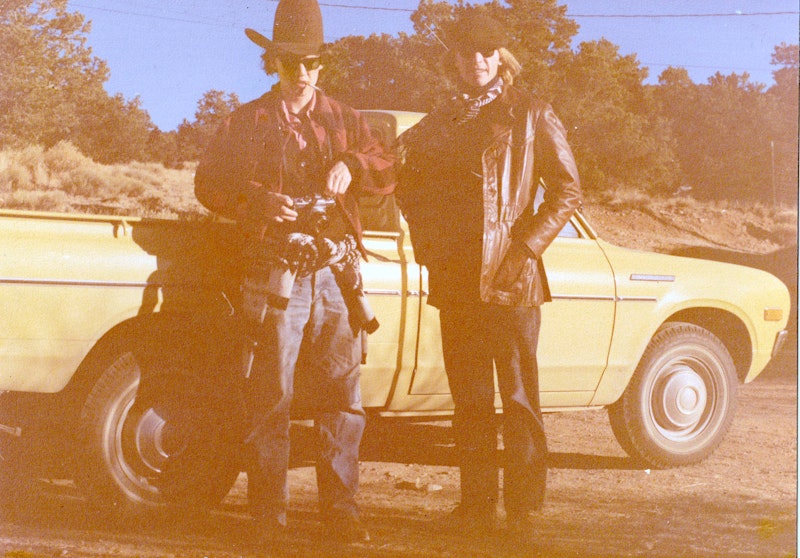Several years before “Deadhead” became either a badge of pride or pejorative—I could never figure out how those nomad fans could follow the band around, didn’t they have to work?—I was a middling Grateful Dead kind of guy, had a few of the early records, including the live double-LP Skull Fuck, as it was known. Last weekend I posted my favorite song from that record, the John Phillips-penned “Me and My Uncle” on Twitter just for the hell of it—I dig the 29 versions of who said “bloodbath” and when, think it has legs going forward to the election, but the eggheads captured that line of thought—and a limited but spirited exchange with a few buddies took place.
J.D. King, a keen fella I’ve known since 1988 when he regularly contributed illustrations to New York Press (and now writes stories for Splice Today) responded, “Were you there, Hippy Rusty? Did your huaraches wend their way into the Fillmore East? Short train ride from Huntington to NYC.” I wasn’t, but the huaraches reference elicited a question from Davrola, who thought the footwear was favored by chicks, and JD clarified: “Huaraches are "unisex," to use a term favored by hippies,” and then admitted to wearing clogs in the early-1970s, a stand-up move in my book. (A few guys I knew in college wore clogs—one even had an earring, which, at the time, was bold for a “straight”—but they looked way too uncomfortable to me, and would be a hindrance if you had to gallop away from the fuzz on a late night in the danger zone.
I did own huaraches, though it wasn’t until January of ’74, visiting my brother Gary and sister-in-law Teresa in San Francisco, that I picked a pair for 15 bucks or so on some side street in Berkeley. I’d never seen huaraches before—a West Coast upgrade on traditional sandals, back when there were specific American regions and the country wasn’t a giant Chipotle; and, for the record, I never, ever, wore flip-flops—but what I bought were sturdy, perhaps “artisanal,” and remained in my pick-up wardrobe until the straps finally wore out shortly after Ronald Reagan dispatched Jimmy Carter and the Killer Bunny.
I replaced them with dirt-cheap black “cop” shoes from an Army Surplus store in Baltimore, and I felt the panache of my footwear skittle down to zero. I also had hand-made cowboy boots, with a burnt-orange hue, that my friend in Houston sent me in the fall of ’74, along with a lid of Mexican, all for the reasonable price of $50. That wasn’t no Bidenomics! (Before the online fact-checkers pounce, I know the 1970s were a lost economic decade—maybe I’ll buy a Ford WIN button on eBay for my son Booker’s birthday—but I got along, and was pretty flush by the time The Great Communicator waved his hand (or maybe that was Nancy and her séance host/astrologer) and it was Morning In America. I can still smell that traditionally-brewed coffee.
Anyway, except for the days when it was below 20 degrees in Baltimore, I’d walk to work up N. Charles St. from Mt. Vernon in those huaraches, padded by two pairs of socks, one a day-glo orange that I’d purchased at the Red Shed on Greenmount Ave., along with the red and black checked jacket in the accompanying picture taken in Santa Fe at Gary’s 7000 feet above sea level cottage—possibly my favorite item of clothing ever—and a few pairs of wild boxers that were 200 percent polyester and, at times, set my world ablaze. The cowboy hat didn’t last long: it’d fly off my head, and once, in a Baltimore movie theater, someone complained that the lid blocked her view.
Tied around my waist is a ratty but cool wool/poly sweater, inherited from my brother Doug when I left for college (he’d purchased it as a Hopkins student years earlier), one that lasted for a decade. My Hopkins buddy G.I. Joe ribbed me for the garment—“How après ski, Russ!”—kind of rich since he attended a fancy Catholic prep school in Rhode Island; on the other hand, like me Joe wasn’t from an affluent family, so I’m guessing his joke was ironic, before irony died years later, until resurrected by Donald Trump, currently America’s top stand-up comedian. (Settle down: the man’s psychotic, but anyone who denies his role as First Humorist spends too much time reading The Atlantic and New Yorker.
Look at clues to figure out the year: The first branch of The Body Shop is opened in Brighton; UK breaks diplomatic relations with Uganda; The Damned released “New Rose”; Sleeping Murder, Agatha Christie’s last novel, is published posthumously; Concorde service begins in Washington, D.C.; The Big Red Machine reigns; Keri Russell is born and Fritz Lang dies; David Bowie is arrested in Rochester for possession of marijuana; Rainer Werner Fassbinder begins his descent into a cocaine addiction that would later kill him; Saul Bellow wins the Nobel and Pulitzer prizes for literature; Kingsley Amis’ The Alteration is published; John Lennon finally gets his green card; Bruce Springsteen jumps a wall at Graceland is quickly escorted off the grounds; and, unfathomably, 50,000 people (in the rain) attend a free Jefferson Starship concert in Central Park.
—Follow Russ Smith on Twitter: @MUGGER2023

